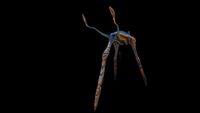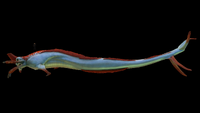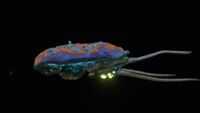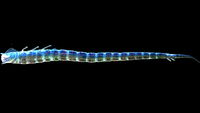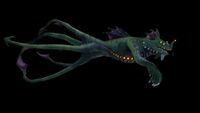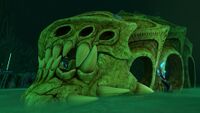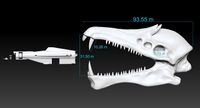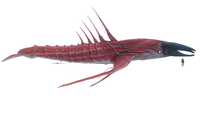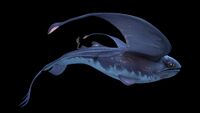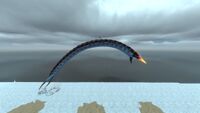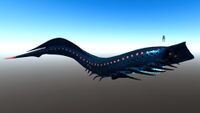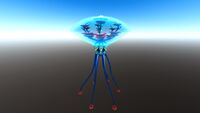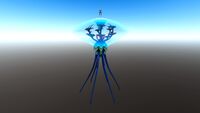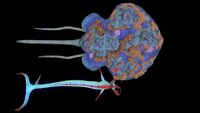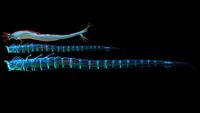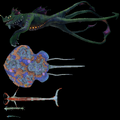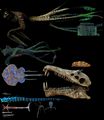Leviathan Class Organisms: Difference between revisions
No edit summary |
(Undo revision 525739 by YoIsMamaGay (talk)) Tags: Undo mobile web edit mobile edit |
||
| (33 intermediate revisions by 16 users not shown) | |||
| Line 1: | Line 1: | ||
{{Spoiler}} |
{{Spoiler}} |
||
{{DISPLAYTITLE:''Leviathan'' Class Organisms}} |
|||
__NOTOC__ |
__NOTOC__ |
||
Leviathan is a classification given to extremely large creatures of the Subnautica universe. Any fauna species large enough to lack natural predators can be classified as Leviathan; they need not be predatory. |
|||
'''Leviathan''' is a classification given to extremely large creatures of the Subnautica universe. Although the wording of the [[Reaper Leviathan|Reaper Leviathan's]] databank entry would seem to imply that the leviathan classification is exclusive to predatory life forms, this is not the case; any fauna species of a suitable size can be classified as a Leviathan. |
|||
Although the term "Leviathan" is used to refer to a large mythical aquatic creature in the real world, there is no confirmation on whether the Leviathan classification is restricted to fauna in the Subnautica universe, or is simply the term used for any species of a sufficient size. |
Although the term "Leviathan" is used to refer to a large mythical aquatic creature in the real world, there is no confirmation on whether the Leviathan classification is restricted to fauna in the Subnautica universe, or is simply the term used for any species of a sufficient size. |
||
==Relation to Other Leviathans== |
==Relation to Other Leviathans== |
||
Leviathan is not part of a taxonomic classification so does not imply any of the species classified as such are related |
Leviathan is not part of a taxonomic classification, so does not imply any of the species classified as such are related. In fact, the only two that appear to have any close relation are the [[Sea Emperor Leviathan]] and [[Sea Dragon Leviathan]] who share several features including an almost identical body shape, seven identically positioned tentacles dotted with glowing spots, two forelimbs and a pair of light-producing organs atop their snouts. These two most likely shared a common ancestor that has since diverged into a smaller, cave-dwelling predatory species and a larger, planktivorous species residing in the open ocean. |
||
These two most likely shared a common ancestor that has since diverged into a "smaller", cave-dwelling predatory species and a larger, planktivorous species residing in the open ocean. |
|||
Another pair of Leviathans that seem to be related are the [[Shadow Leviathan]] and the [[Ice Worm]]. Both of which have elongated serpentine bodies lined with several parapodia, have large distinct blade-shaped heads, blackened skin, and feed with monstrous mandibles. This indicates that they had a common ancestor with a body plan much like that of a centipede crossed with a worm. |
|||
==Leviathans of the Past== |
==Leviathans of the Past== |
||
Despite being enormous when compared to the fauna of Earth, the leviathans inhabiting [[Planet 4546B]] in the present day are dwarfed by their predecessors; the three-million-year-old [[Gargantuan Fossil]] at full length is estimated to be 6-8 times longer than an adult [[Sea Emperor Leviathan]] specimen. To support a predator of such titanic proportions, many of the other creatures of that time period must have also been of colossal proportions. |
Despite being enormous when compared to the fauna of Earth, the leviathans inhabiting [[Planet 4546B]] in the present day are dwarfed by their predecessors; the three-million-year-old [[Gargantuan Fossil]] at full length is estimated to be 6-8 times longer than an adult [[Sea Emperor Leviathan]] specimen. To support a predator of such titanic proportions, many of the other creatures of that time period must have also been of colossal proportions. |
||
The one-million-year-old [[Ancient Skeleton]] is |
The one-million-year-old [[Ancient Skeleton]] is a massive, well-intact, skeletal structure consisting of a head attached to a unique armored carapace. It's size surpasses that of the living leviathans, and gaps in the teeth are large enough for [[Ryley Robinson]] to swim through comfortably. The totality of the ancient skeleton is unknown; consequently, it's locomotion and original size cannot be pinpointed. The bulky armored skeleton is around 100 meters in length, giving it more body mass than anything alive on the planet today. |
||
Even some non-leviathan fauna used to be huge enough to qualify. With the most notable being the one thousand-year-old [[Research Specimen Theta]] which out of all of the extinct Leviathans, was by far the smallest. Despite this, it is colossal in comparison to some of its modern relatives including the [[Biter]] and [[Sand Shark]]. It is recognized as being their ancestor as it has both the Biter's double eye sockets, while also having a tough armored shell like the Sand Shark. Unlike either of them, it actually possesses a pair of forearms which considering they were facing backwards were most likely a pair of flippers. |
|||
In order to support creatures of these magnitudes (if any are still alive currently in 4546B), it is mandatory for these creatures to reside tens (if not hundreds) of kilometers away from the [[Crater Edge]] for their space along with food supply to be satisfied enough for sustenance and survival. As well as this, they would have to feed on fully grown leviathans that feed on smaller leviathans or microscopic creatures (such as [[Ghost Leviathan|Adult Ghost Leviathans]] or other organisms of the same caliber as the latter). |
|||
==Known Leviathan Class Organisms== |
==Known Leviathan Class Organisms== |
||
===[[The Crater]]=== |
===[[The Crater]]=== |
||
*[[Sea Treader]]: |
*[[Sea Treader]]: About 20 meters (65 feet) |
||
*[[ |
*[[Reaper Leviathan]]: 55 meters (180 feet) |
||
*[[Reefback]]: About 70 meters (229 feet) |
|||
*[[ |
*[[Ghost Leviathan|Ghost Leviathan Adult]]: 110 meters (360 feet) |
||
**[[Ghost Leviathan Juvenile]]: About 67 meters (219 feet) |
|||
*[[Reefback]]: Around 70 meters in length yet also extremely broad, making it one of the largest creatures |
|||
*[[ |
*[[Sea Dragon Leviathan]]: 112 meters (367 feet) |
||
*[[Sea Emperor Leviathan]]: 160 to 200 meters (524 to 656 feet) |
|||
*[[Sea |
**[[Sea Emperor Leviathan Juvenile]]: About 80 to 90 meters (262 to 295 feet) |
||
*[[Sea Emperor Leviathan]]: |
**[[Sea Emperor Leviathan Baby]]: About 1.5 meters (5 feet) |
||
**[[Sea Emperor Leviathan (Juveniles)|Sea Emperor Leviathan Juvenile]]: Around 60 meters |
|||
**[[Sea Emperor Leviathan (Babies)|Sea Emperor Leviathan Baby]]: Around 1.5 meters |
|||
===[[Sector Zero]]=== |
===[[Sector Zero]]=== |
||
*[[Glow Whale]] |
*[[Glow Whale]]: 30 meters (98 feet) |
||
* [[Chelicerate]] |
* [[Chelicerate]]: 40 meters (131 feet) |
||
**[[Chelicerate#Void Chelicerate|Void Chelicerate]] |
**[[Chelicerate#Void Chelicerate|Void Chelicerate]]: 65 meters (213 feet) |
||
* [[Shadow Leviathan]] |
* [[Shadow Leviathan]]: 60 meters (197 feet) |
||
* [[Ice Worm]] |
* [[Ice Worm]]: 95 meters (311 feet) |
||
* [[Ventgarden]] |
* [[Ventgarden]]: 110 meters (361 feet) in height |
||
**[[Juvenile Ventgarden]] |
**[[Juvenile Ventgarden]]: About 22 meters (72 feet) in height |
||
The [[Squidshark]] is |
The [[Squidshark]] is about 11 meters in length, and described as "a leviathan-class predator at the smaller end of the scale" by its databank entry. However, the squidshark is excluded from the databank's leviathan tab. |
||
==Extinct Leviathan Class Organisms== |
==Extinct Leviathan Class Organisms== |
||
===Crater=== |
===Crater=== |
||
| ⚫ | |||
*[[Research Specimen Theta]]: - ~21 meters |
|||
| ⚫ | |||
| ⚫ | |||
| ⚫ | |||
===Sector Zero=== |
===Sector Zero=== |
||
*[[Frozen Leviathan]] |
*[[Frozen Leviathan]]: About 70 meters (230 feet) excluding tail; about 150 meters (492 feet) total. |
||
==Size Comparisons== |
==Size Comparisons== |
||
| Line 63: | Line 56: | ||
SeaDragonLeviathan18.jpg|Sea Dragon Leviathan (player in front of mouth) |
SeaDragonLeviathan18.jpg|Sea Dragon Leviathan (player in front of mouth) |
||
CacheSkeletonSizeref2.jpg|Ancient Skeleton (player in mouth) |
CacheSkeletonSizeref2.jpg|Ancient Skeleton (player in mouth) |
||
Skull.jpg|Gargangtuan fossil size compared to Ryley, Seamoth, Prawn Suit and Cyclops (comparison by [[User blog:Jurandfantom/Wasabi One "sizeref" object height - around 168 cm|user Jurandfantom]]) |
|||
Chelicerate Size Comparison.png|Chelicerate size comparison |
Chelicerate Size Comparison.png|Chelicerate size comparison |
||
VoidCheliceratesizeref.jpg|Void Chelicerate size comparison |
VoidCheliceratesizeref.jpg|Void Chelicerate size comparison |
||
| Line 81: | Line 74: | ||
</gallery> |
</gallery> |
||
</tabber> |
</tabber> |
||
==Trivia== |
|||
*Some fauna on Earth may fit in the categorization of Leviathans, such as the [[Wikipedia:Whale Shark|whale shark]], as well as large whales, including the [[Wikipedia:Humpback Whale|humpback whale]] and the [[Wikipedia:Blue whale|blue whale]]. |
|||
[[fr:Classe Léviathan]] |
[[fr:Classe Léviathan]] |
||
Latest revision as of 12:58, 10 December 2024

|
Read at own risk This article contains unmarked spoilers. Players new to the game would want to avoid or be cautious toward this article. |
Leviathan is a classification given to extremely large creatures of the Subnautica universe. Although the wording of the Reaper Leviathan's databank entry would seem to imply that the leviathan classification is exclusive to predatory life forms, this is not the case; any fauna species of a suitable size can be classified as a Leviathan.
Although the term "Leviathan" is used to refer to a large mythical aquatic creature in the real world, there is no confirmation on whether the Leviathan classification is restricted to fauna in the Subnautica universe, or is simply the term used for any species of a sufficient size.
Relation to Other Leviathans
Leviathan is not part of a taxonomic classification, so does not imply any of the species classified as such are related. In fact, the only two that appear to have any close relation are the Sea Emperor Leviathan and Sea Dragon Leviathan who share several features including an almost identical body shape, seven identically positioned tentacles dotted with glowing spots, two forelimbs and a pair of light-producing organs atop their snouts. These two most likely shared a common ancestor that has since diverged into a smaller, cave-dwelling predatory species and a larger, planktivorous species residing in the open ocean.
Leviathans of the Past
Despite being enormous when compared to the fauna of Earth, the leviathans inhabiting Planet 4546B in the present day are dwarfed by their predecessors; the three-million-year-old Gargantuan Fossil at full length is estimated to be 6-8 times longer than an adult Sea Emperor Leviathan specimen. To support a predator of such titanic proportions, many of the other creatures of that time period must have also been of colossal proportions.
The one-million-year-old Ancient Skeleton is a massive, well-intact, skeletal structure consisting of a head attached to a unique armored carapace. It's size surpasses that of the living leviathans, and gaps in the teeth are large enough for Ryley Robinson to swim through comfortably. The totality of the ancient skeleton is unknown; consequently, it's locomotion and original size cannot be pinpointed. The bulky armored skeleton is around 100 meters in length, giving it more body mass than anything alive on the planet today.
Known Leviathan Class Organisms
The Crater
- Sea Treader: About 20 meters (65 feet)
- Reaper Leviathan: 55 meters (180 feet)
- Reefback: About 70 meters (229 feet)
- Ghost Leviathan Adult: 110 meters (360 feet)
- Ghost Leviathan Juvenile: About 67 meters (219 feet)
- Sea Dragon Leviathan: 112 meters (367 feet)
- Sea Emperor Leviathan: 160 to 200 meters (524 to 656 feet)
- Sea Emperor Leviathan Juvenile: About 80 to 90 meters (262 to 295 feet)
- Sea Emperor Leviathan Baby: About 1.5 meters (5 feet)
Sector Zero
- Glow Whale: 30 meters (98 feet)
- Chelicerate: 40 meters (131 feet)
- Void Chelicerate: 65 meters (213 feet)
- Shadow Leviathan: 60 meters (197 feet)
- Ice Worm: 95 meters (311 feet)
- Ventgarden: 110 meters (361 feet) in height
- Juvenile Ventgarden: About 22 meters (72 feet) in height
The Squidshark is about 11 meters in length, and described as "a leviathan-class predator at the smaller end of the scale" by its databank entry. However, the squidshark is excluded from the databank's leviathan tab.
Extinct Leviathan Class Organisms
Crater
- Ancient Skeleton: Exposed skeleton around 95 meters (311 feet), full size unknown
- Gargantuan Fossil: Around 1,100 to 1,300 meters (4,265 feet)
Sector Zero
- Frozen Leviathan: About 70 meters (230 feet) excluding tail; about 150 meters (492 feet) total.
Size Comparisons
<tabber> Against Player=
Gargangtuan fossil size compared to Ryley, Seamoth, Prawn Suit and Cyclops (comparison by user Jurandfantom)
|-| Against Other Creatures=
Approximate comparison between two non-Leviathans, a River Prowler and Ampeel, and three leviathans, a Reaper Leviathan, Reefback Leviathan and Sea Dragon Leviathan
</tabber>

